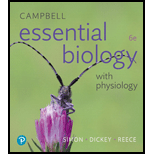
An atom can be changed into an ion by adding or removing _____. An atom can be changed into a different isotope by adding or removing________.
To determine: The sub-atomic particles whose addition or subtraction can give rise to an ion and an isotope.
Introduction:
The atom is the smallest unit of biological organization. However, there are particles even smaller than an atom and that together make up the atom. These sub-atomic particles include protons, neutrons, and electrons. In the center of an atom, the nucleus is present, which is composed of protons (positively charged particles) and neutrons (neutral particles). Electrons (negatively charged particles) revolve around the nucleus in designated orbitals.
Answer to Problem 1SQ
Correct answer: An atom can be changed into an ion by adding or removing electrons. An atom can be changed into a different isotope by adding or removing neutrons.
Explanation of Solution
An ion is a charged particle formed by the atoms to attain stability. Atoms can either form a positively charged ion called a cation or a negatively charged ion called an anion. Ions are formed by the change in the number of electrons. If electrons are lost, the positive charge on the atom increases and it forms a cation. If electrons are gained by the atom, the atom gets negatively charged and forms an anion. For example, the sodium (
Isotopes are variants of the same element but with different mass. The mass of an atom is composed of the masses of protons and neutrons in the nucleus. If the number of protons is changed, the element will change. Thus, for the formation of an isotope, the number of neutrons is supposed to change. For example, the isotopes of hydrogen (zero neutrons) include protium (zero neutrons), deuterium (one neutron) and tritium (two neutrons).
To form an ion, the number of electrons is supposed to be changed and to form an isotope, the number of neutrons is supposed to change.
Want to see more full solutions like this?
Chapter 2 Solutions
Campbell Essential Biology with Physiology (6th Edition)
Additional Science Textbook Solutions
HUMAN ANATOMY
Genetics: From Genes to Genomes
Campbell Essential Biology (7th Edition)
Physical Science
Laboratory Manual For Human Anatomy & Physiology
- Identify the indicated structure (Saprolegnia). a. antheridium O b. oospore c.sperm d. auxospore e. tetraspore Of. zygosporearrow_forwardUsing information from the primary literature (several references have been provided as a starting point below) please answer the following question: Based on your review of the literature on rewilding, what are the major scientific pros and cons for rewilding? Please note that the focus of this assignment are the (biological) scientific issues associated with rewilding. As will be discussed in class, there are a number of non-scientific issues involved or implicated in rewilding, all ultimately affecting the public acceptability of rewilding. Although these issues are important – indeed, critical – in this assignment you should focus on the biological science issues and questions. Details: You must enumerate at least two pros and at least two cons. Your answer should be no more than 500 well-chosen words, excluding references. Think carefully about how best to organize and structure your answer. Aim for high information density: say a lot, but say it succinctly. Recall Nietzche’s…arrow_forwardUsing information from the primary literature (several references have been provided as a starting point below) please answer the following question: Based on your review of the literature on rewilding, what are the major scientific pros and cons for rewilding? Please note that the focus of this assignment are the (biological) scientific issues associated with rewilding. As will be discussed in class, there are a number of non-scientific issues involved or implicated in rewilding, all ultimately affecting the public acceptability of rewilding. Although these issues are important – indeed, critical – in this assignment you should focus on the biological science issues and questions. Details: You must enumerate at least two pros and at least two cons. Your answer should be no more than 500 well-chosen words, excluding references. Think carefully about how best to organize and structure your answer. Aim for high information density: say a lot, but say it succinctly. Recall Nietzche’s…arrow_forward
- Now draw a rough sketch of what the control data might look like if in addition to the specific binding, there was also a considerable amount of nonspecific binding (again using a normal dose/response curve) (do % total bound ligand vs concentration)arrow_forwardWhat are functions of cuboidal cells in the kidney? Select all that apply. Concentration of gases Dilution of chemicals Secretion of molecules Nutrition to tissues Support of tissues Absorption of moleculesarrow_forwardquestion1 In plants, epithelial tissue is only found as the outermost cell layer and acts as a barrier. In humans, epithelial tissue is found inside the body as well as on the surface. What function(s) does/do epithelial tissue carry out in humans? Select all that apply. Waste storage Filtration Oxygen transport Protection Diffusion Osmosis Absorptionarrow_forward
- What words best describes this organism? a. Unicellular/nonmotile Ob. unicellular/motile c. colonial/nonmotile d. colonial/motile e. multicelluar O f. siphonous g. none of thesearrow_forwardIdentify the phylum or class. a. Euglenophyta b. Dinoflagellata c. Bacillariophyceae d. Oomycetes e. Phaeophyceae O f. Myxomycota g. Xanthophyceae ○ h. Chrysophyceae i. Dictyosteliomycota O j. Rhodophyta Ok. Chlorophyceaens I. Charophyceaensarrow_forwardWhat is produced inside the indicated structure (Fucus). a. eggs O b. antheridia ○ c. sperm d. zygotes e. none of thesearrow_forward
 Concepts of BiologyBiologyISBN:9781938168116Author:Samantha Fowler, Rebecca Roush, James WisePublisher:OpenStax College
Concepts of BiologyBiologyISBN:9781938168116Author:Samantha Fowler, Rebecca Roush, James WisePublisher:OpenStax College
 Biology Today and Tomorrow without Physiology (Mi...BiologyISBN:9781305117396Author:Cecie Starr, Christine Evers, Lisa StarrPublisher:Cengage Learning
Biology Today and Tomorrow without Physiology (Mi...BiologyISBN:9781305117396Author:Cecie Starr, Christine Evers, Lisa StarrPublisher:Cengage Learning Biology 2eBiologyISBN:9781947172517Author:Matthew Douglas, Jung Choi, Mary Ann ClarkPublisher:OpenStax
Biology 2eBiologyISBN:9781947172517Author:Matthew Douglas, Jung Choi, Mary Ann ClarkPublisher:OpenStax





